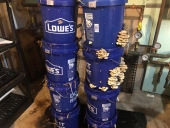





 1
1







 1
1




Check out Redhawk's soil series: https://permies.com/wiki/redhawk-soil
 2
2




 1
1




'What we do now echoes in eternity.' Marcus Aurelius
How Permies Works Dr. Redhawk's Epic Soil Series




"You must be the change you want to see in the world." "First they ignore you, then they laugh at you, then they fight you, then you win." --Mahatma Gandhi
"Preach the Gospel always, and if necessary, use words." --Francis of Assisi.
"Family farms work when the whole family works the farm." -- Adam Klaus




Joylynn Hardesty wrote:He used the stem butts in the video to propagate the mushrooms which still had dirt/particles attached to the ends. Is this needed, or would grocery store purchased stem ends also work? Might the particles/dirt inhibit proper inoculation? Before permies, I'd thought it all had to be sterile lab conditions for people to succeed with mushrooms.












Joylynn Hardesty wrote:Before permies, I'd thought it all had to be sterile lab conditions for people to succeed with mushrooms.
'What we do now echoes in eternity.' Marcus Aurelius
How Permies Works Dr. Redhawk's Epic Soil Series

 1
1
















'What we do now echoes in eternity.' Marcus Aurelius
How Permies Works Dr. Redhawk's Epic Soil Series

















'What we do now echoes in eternity.' Marcus Aurelius
How Permies Works Dr. Redhawk's Epic Soil Series
 1
1




Joylynn Hardesty wrote:He used the stem butts in the video to propagate the mushrooms which still had dirt/particles attached to the ends. Is this needed, or would grocery store purchased stem ends also work? Might the particles/dirt inhibit proper inoculation? Before permies, I'd thought it all had to be sterile lab conditions for people to succeed with mushrooms.




Joylynn Hardesty wrote:Yesterday I bought portabella babies and buttons at the grocery store. Yay!
 1
1




It's time to get positive about negative thinking  -Art Donnelly
-Art Donnelly













I would hazard a guess: 3% peroxide kills bacteria and other dead, infected material. For instance when you use it on a cut, it cleans around healthy cells. I think that it does kill off single mushroom spores, but not growing live mycelial tissue. So using peroxide this way may help eliminate competition of yeasts, bacterias, anything rotten or spoiling. I am not a mycologist, just a hobbyist. Anyone have a more scientific answer?Why doesn't the peroxide kill the spores you are trying to cultivate?
You do not have to be good. You do not have to walk on your knees for a hundred miles through the desert repenting. You only have to let the soft animal of your body love what it loves. -Mary Oliver




I live in Bizzaro World.
 1
1








Christine
Living Local at Kapelle Gardens

 1
1




john giroux wrote:Why doesn't the peroxide kill the spores you are trying to cultivate? I have taken a jar, fit screen over the mouth and boiled. Then place a mushroom to drop spores into the water.





Mark Lee wrote:Joseph,
Your picture of oyster mushroom spores growing after 3 days is fascinating. I would like to know more details.
It looks like you just poured the peroxide+spore solution right onto the cut face of the log. Is that correct?
What environment was the log in (temperature, moisture, indoor/outdoor)?
What kind of wood?
Was it recently cut or had it aged?
Did the log ever fruit?
Did the spores come from your own oysters, store bought, or wild?
Have you done this technique with any other kinds of mushrooms?
-Mark, Seattle
 2
2








If it survives in my garden, it was meant to live!

|
I don't always make ads but when I do they're tiny
The new gardening playing cards kickstarter is now live!
https://www.kickstarter.com/projects/paulwheaton/garden-cards
|







